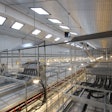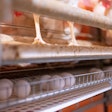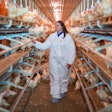
Because of its size and the high visibility of its brand, McDonald’s has become a target for just about every activist group out there. The resulting public relations smear campaigns have resulted in the fast food giant making several changes in its purchasing practices for items as diverse as eggs, coffee, chicken meat and packaging materials.
As part of McDonald’s transparency efforts, the company has commissioned articles and videos explaining where its food ingredients come from and how they are produced. One such effort is an article produced by Food.Mic titled, How Demand for Cage-Free Eggs Is Pushing Farmers to Look for the Sunny-Side. The text of the article is all right as far as it goes, but the stock photo chosen to represent cage housing for layers in the U.S. is wrong on several key aspects.
The layer house is essentially a pole barn with curtain sides. There is no automatic feeder and no manure or egg belts. Given all this and the plastic bins in front of every cage, I can only assume this is a picture of some sort of research facility in a tropical climate and each bin has food for a particular cage.
McDonald’s was a sponsor of the Coalition for a Sustainable Egg supply research. I would think they might have access to photographs of the cage-housed hens from these studies, which took place in modern hen houses on a working large-scale U.S. egg farm.
I assume this article is attempting to educate consumers about the changes taking place in the U.S. egg industry, but this picture doesn’t reflect current industry practices for cage housing. Maybe the Food.Mic people didn’t know any better, but the McDonald’s folks should know what their egg suppliers' hen houses really look like. Perhaps McDonald’s transparency campaign should have started with a little education for its public relations team.


















